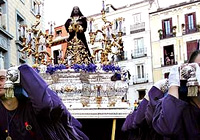Truly one of Spain's most breathtaking celebrations, Easter is a one-of-a-kind display of tradition, music, culture, theatre and religion. If you're thinking of learning Spanish, consider doing so during Semana Santa! One of the best parts of Enforex is that we're open all year round, even during festivals like this!
The south is the best place to experience a Semana Santa in Spain, making our schools in Granada, Sevilla and Marbella prime destinations to both learn Spanish and discover the magic of this world-famous festival.
While there's nothing quite like experiencing Semana Santa (Holy Week) in person, keep reading for all sorts of background information on the celebration's history, traditions and more!
When and where Is Semana Santa?
The dates of the celebration vary on a yearly basis, given that the feast is not attached to a specific date but rather to a cosmic phenomenon. Linked ever since the Roman emperor Constantine the Great called the Council of Nicaea in 325 A.D. to the first Sunday after the full moon following the vernal equinox in the northern hemisphere, Easter can never be celebrated before March 22 (the day after the vernal equinox) or after April 25. Therefore, you can roughly plan on early spring to see Spain's famous processions, but you should check your calendar before making any definite plans.
Cities, towns, and villages across all of Spain come to life during Semana Santa. While each city has its own unique Holy Week celebrations, tag sunny Seville as your main destination for an experience that will leave you absolutely speechless.


Semana Santa Traditions
The holiday, jubilant in Seville and Andalucía and solemn elsewhere in Spain, is practically defined by its stunning processions. Each of these processions typically boasts two intensely adorned floats, one of the Virgin and the other of a scene from Christ's Passion. Take in the lavish decoration of these incredible creations as they slowly pass before you accompanied by the music of coronets and drums; its hard to do without getting chills. Underneath each float, you'll just barely be able to make out rows and rows of feet. There are up to forty men, called costaleros, who haul the float on shoulders and control its swaying motion. In fact, they practice so much and are so in sync with each other that the realistic figures on top look eerily as if they were walking along to the music.
Impossible to miss are the seemingly endless rows of nazarenos, or penitents, who walk along with the float.. You may even see many nazarenos walking barefoot, which is pretty impressive, considering some of the processions last up to 14 hours! Oh, and don't be thrown off by the resemblance between the pointy hoods and long robes of the nazarenos and those of the Ku Klux Klan: it's coincidental and completely unrelated.
Don't be surprised to see how nicely the people dress to watch the processions, especially during the second half of the week. Women often dress to the nines while many men brave the sun in full suits. Of course not everybody dresses up so much, but, basically, if you want to fit in watching the processions, just leave the t-shirt you wore to paint your garage behind.
History of Semana Santa
As with any cultural celebration, Spain's elaborate Semana Santa was for centuries a work-in-progress. The starting point for its extensive history is clearly the death of Christ, from which it takes its subject, however the celebration that we see today is the result of centuries of evolution.
A significant point in the history of the Semana Santa is 1521, when the Marqués de Tarifa returned to Spain from the Holy Land. After his journey, he institutionalized the Via Crucis (Stations of the Cross) in Spain and from that moment on this holy event was celebrated with a procession. Over time, the observance of the Via Crucis eventually broke up into the various scenes of the Passion, with the incorporation of portable crosses and altars. This would eventually lead to today's elaborate processions.
Check out any map of Semana Santa routes and you will see the Carrera Oficial, or official route, clearly marked. This original route, while it has evolved since 1604, continues to serve as the backbone for the present route. The final major step took place in the 17th century, when Seville's various cofradías (brotherhoods) began dividing and organizing themselves into what they are today.




